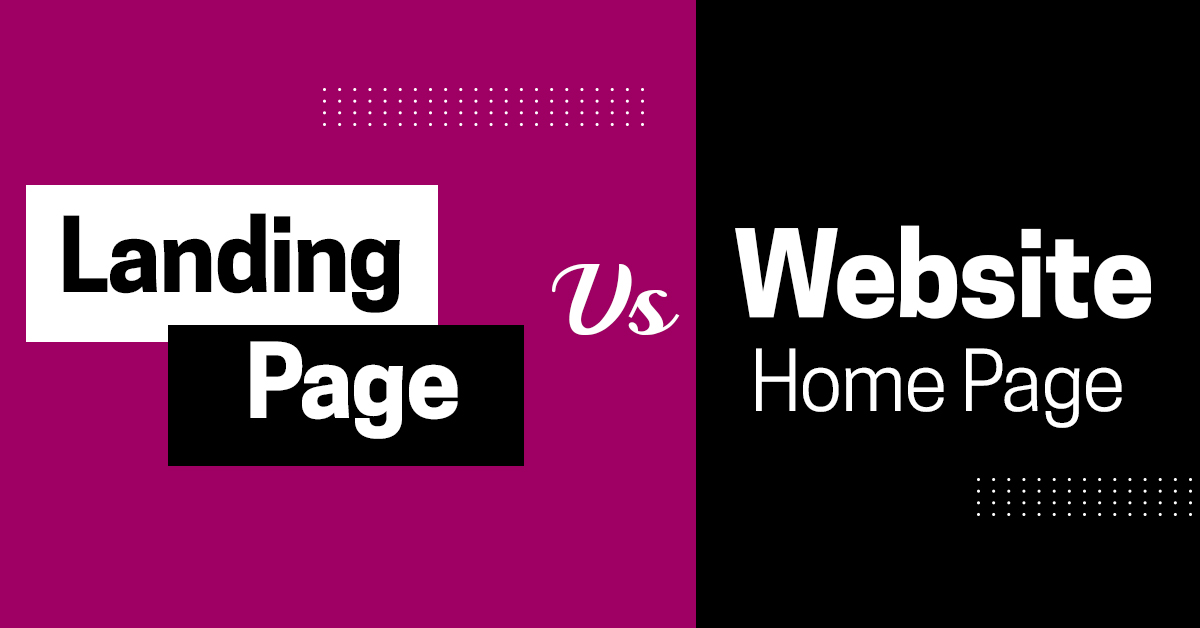For those newer to the digital marketing game, you may be wondering, “what’s the difference between a landing page and the home page of your website?” After all, in layman’s terms, the two seem like they should be practically identical, don’t they? When someone goes to your business website, the first thing they see is your home page, right? So doesn’t that make it a “landing page”?
In reality, landing pages and website home pages are quite different in many ways, and just because the two sound similar, that doesn’t mean you should treat them the same way! Landing pages and home pages have some key similarities, it’s true, but they differ significantly in some very important ways.
In general, the difference between a landing page and a website homepage is this: A landing page is a purpose-built web page, usually the destination of a marketing campaign, designed to get visitors to take a specific, intended action. These marketing campaigns can be paid ads (pay-per-click, or “PPC”), social media campaigns, email marketing, and so on.
On the other hand, a home page is the main page of a website, designed to give an overview of a business’ primary offerings.
Landing pages and home pages can differ in many important ways, usually including the following:
- What the purpose or goal of the page is
- How one arrives at the page
- How the page is designed
- The software used to create the page
There are many other factors that differentiate between a landing page vs. a website home page, but these are the most common and most important ones. In this blog, we’ll look at all the various factors of landing pages and home pages so you can have a comprehensive, full understanding.
Table of Contents
Landing Page vs. Home Page: What’s the Purpose of the Page?
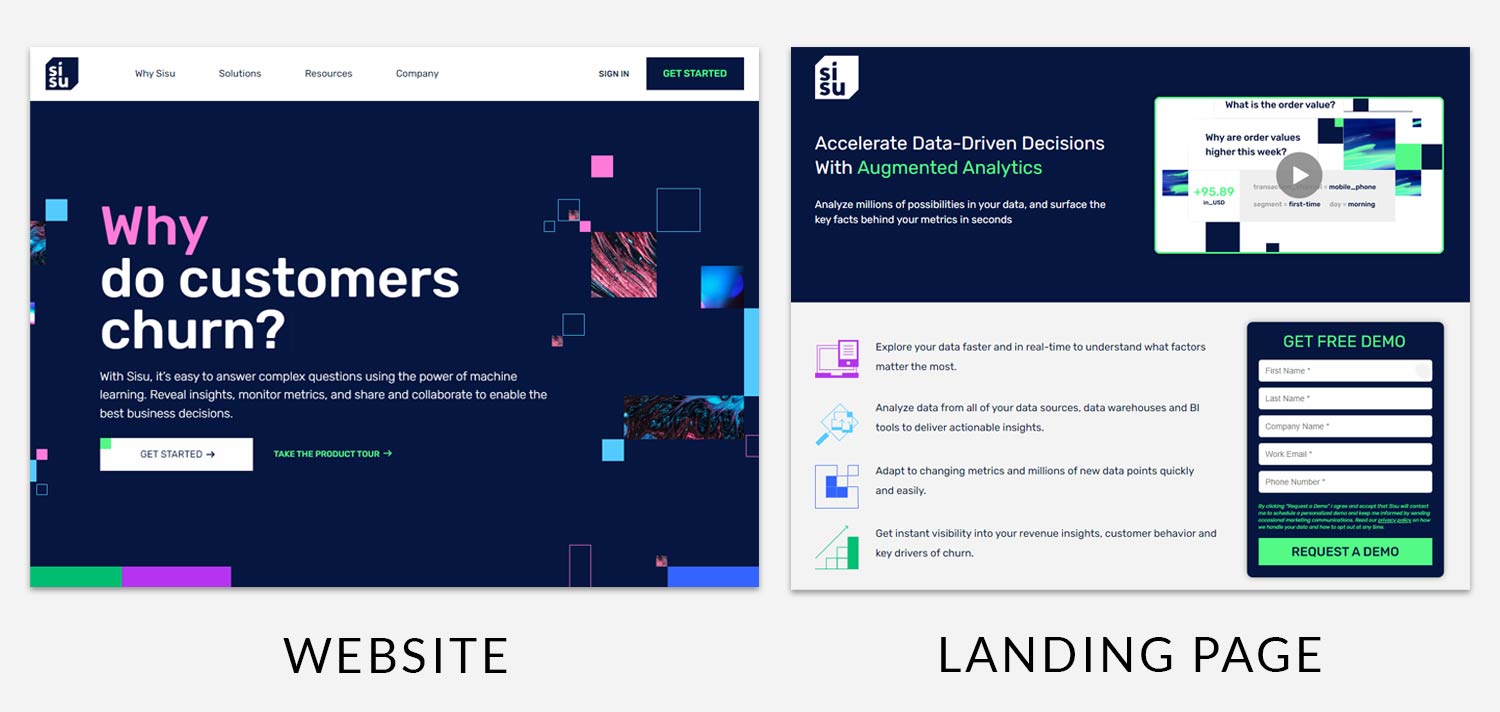
The most obvious and significant difference between a landing page and your website home page is what the purpose or goal of the website is. It’s true that for individuals new to your brand, both a landing page and a home page can be the first encounter they have with what you, or your clients, have to offer.
A home page of your site is just that – the page that people arrive at when they click your link. If your business is XYZ, when an individual goes to the URL bar of their browser and types in XYZ.com, the page that pops up is your website home page.
The purpose of a home page should be informational. For many, this will be the first encounter they have with your brand beyond whatever brought them to your site – perhaps word of mouth. The home page should clearly and effectively communicate:
- The general goods or services a brand offers. Do you sell shoes? Do you offer expert consulting for HVAC systems? Do you offer graphic design? Your home page should say so! A visitor to your home page should be able to understand just what a brand has to offer them, at least on a high level.
- Your brand’s voice and style. The home pages of a graphic designer, a consulting agency, and a trendy food truck won’t just advertise different services, they’ll all likely look – and sound – very different. Would you think an arcade whose home page was written in strict business-speak would be much fun to go visit? Alternatively, would you hire a lawyer whose home page sounded overly casual and made references to their favorite classic video games?
(I might, but that’s besides the point.)
Emotional connection with brands is more important than ever before for consumers. Your home page doesn’t just tell a visitor what your brand does, it tells them how your brand is supposed to make them feel. - How to engage further with the brand. Unlike a landing page (which we’ll get to shortly), driving action isn’t the main purpose of your home page. However, does that mean there shouldn’t be a way at all for someone curious to increase engagement.
For many brands, that may be something as simple as a “contact” link towards the bottom of the page. However, it could also be a link to a demo for a SaaS company, a link to a menu listing for a restaurant, or a mailing list for product deals for an ecommerce brand.
So these are what a home page for a website should be doing. But what about a landing page?
Well, when it comes to the goal of a landing page vs. the goal of a home page, your landing page has a different function. The purpose of a landing page should be action-oriented. That’s not to say that a landing page can’t have information about a service or products, or that it can’t communicate brand tone and style – it can, and it should! But these are not the primary goals of a landing page.
To put it in other words, a landing page exists to try and get a visitor to take a desired action for a specific brand or product. This can include things like:
- Signing up for a mailing list
- Signing up for an event, like a webinar or other occasion
- Taking a demo of a software solution
- Purchasing a product
- Downloading premium content like an ebook
- Collecting personal contact information
In other words, depending on the landing page, the purpose of the page should be to move them down the marketing funnel. An initial touchpoint with a “cold” audience may not be designed to drive a sale that moment, but to collect contact information that can be used to nurture the potential customer. On the other hand, a page for purchasers more familiar with the brand – at the bottom of the funnel, so to speak – can be more explicit about being a hard sell.
Landing Page vs. Home Page: How Do You Get to the Page?
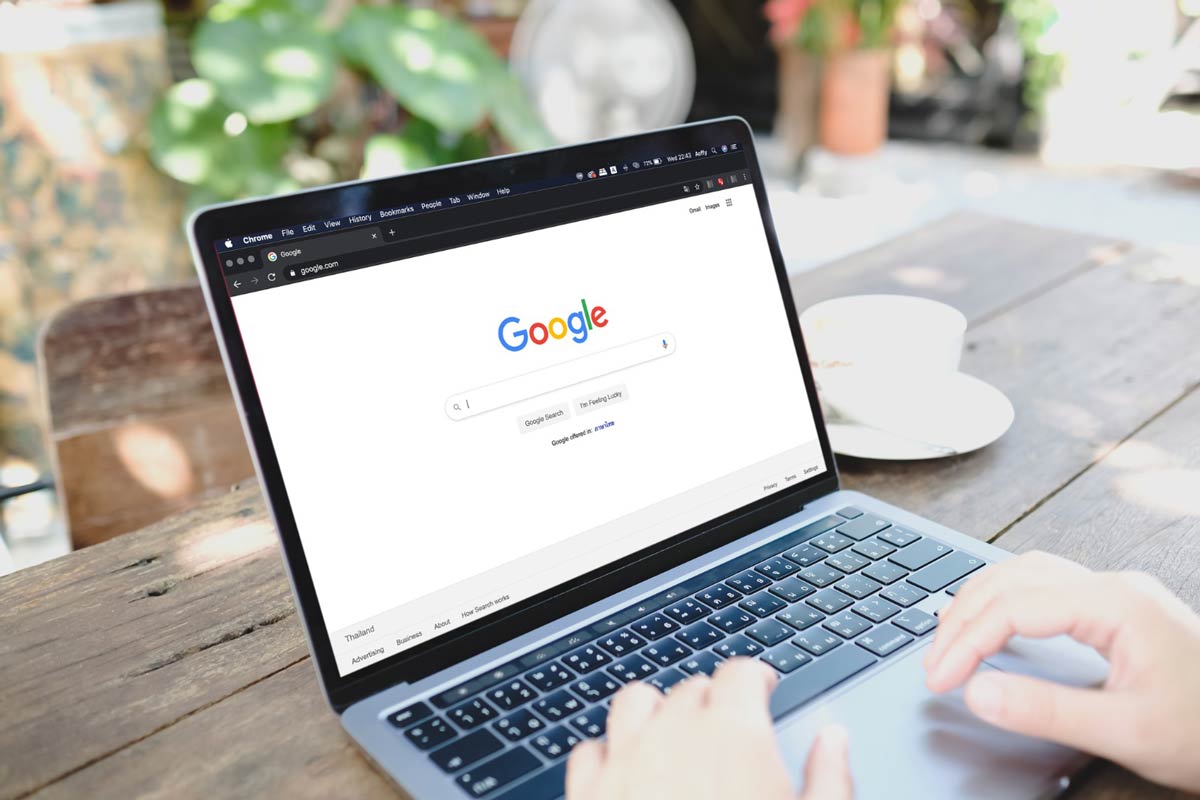
How are you expecting a potential visitor to your site to access the page in question? This is another key difference between landing pages and other pages on your website, though it may seem minor at first.
Think about your home page. How do people usually get to it? There are three main ways, typically, a visitor will arrive on your website’s home page:
- From a search engine query. You sell tennis shoes, someone searches “best tennis shoes for size 11,” you’re a top result, they wind up on your page. Simple enough.
- From another page on your website. Perhaps the above query didn’t take them to your home page. Perhaps you sell lots of shoes, and so googling “best tennis shoes” instead took them to your tennis shoe product page. With proper site navigation, a visitor might be curious as to what else you offer, and so might go to your home page from this other page.
- From external organic marketing. When you make social posts or email people who are on your mailing list, you’ll usually have links both to specific products or services, as well as a link to your home page.
These aren’t the only ways someone can check your website – for instance, what if they see a billboard and enter your URL manually – but they are the most common?
Landing pages, however, almost always have just one type of path to get to them: marketing campaigns. This can take many forms, like email marketing (product announcements to your mailing list sending people who click on it to a landing page, for instance), social media campaigns, and the like, but one of the most common is targeted paid advertising.
When you use PPC advertising to market your site, the destination for your ads will usually be a specifically designed and targeted landing page. There are multiple best practices for aligning landing page copy and design with your ads, but all of that means that PPC ads and landing pages are tightly linked.
So, say the same person used their search engine of choice to look for “best tennis shoes for size 11”. Rather than in organic search results, they would see a paid ad highlighting your tennis shoes for sale, and upon clicking it, they would not go to your home page or product page, but to a custom-designed landing page designed to get them to move further down the sales funnel.
To put it simply: Your home page, like other organic pages, relies on SEO; landing pages rely on PPC campaigns.
For this reason, landing pages don’t necessarily need to be SEO-driven like other pages on your site, since traffic to them is unlikely to be organic. That doesn’t mean you can just ignore the rules of good page design, though!
And speaking of which…
Landing Page vs. Home Page: How Are They Designed Differently?
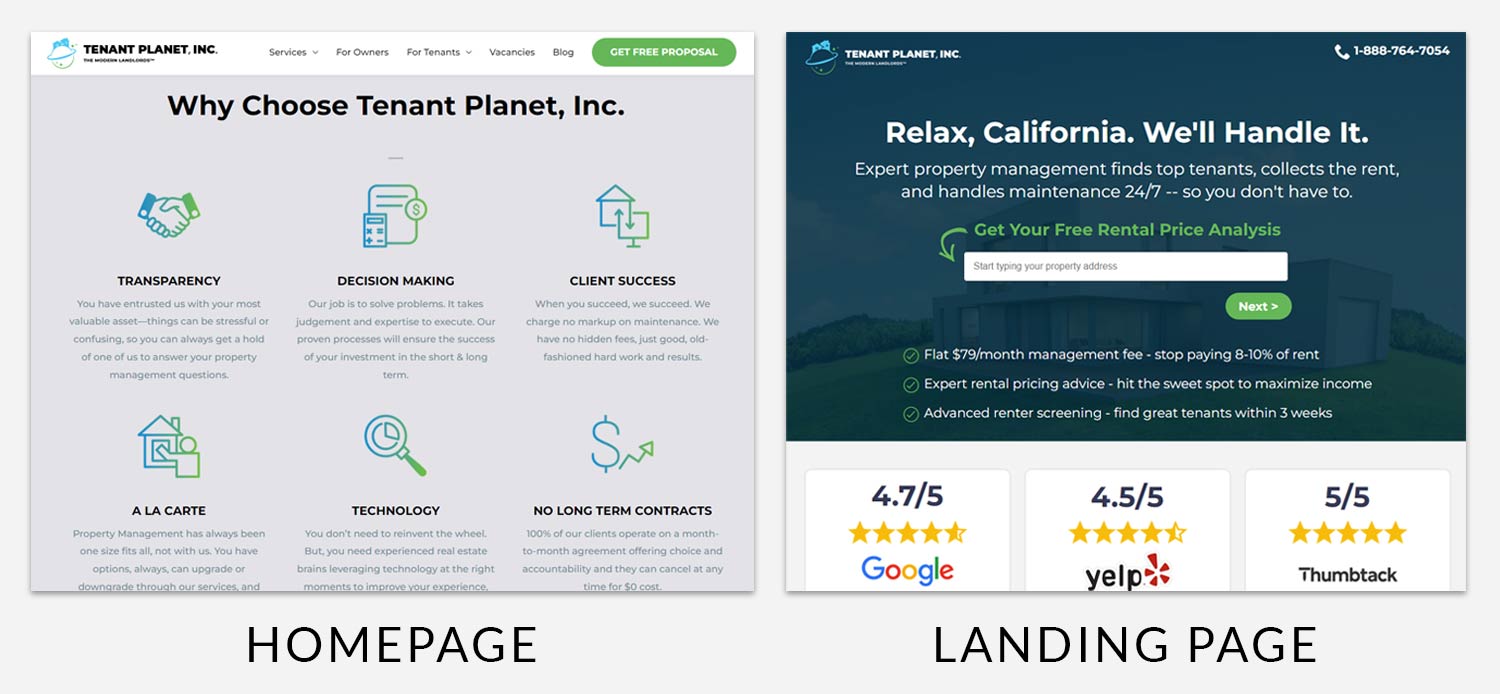
Because a landing page has a much more tightly defined scope, the design tends to be, well, a lot tighter than that of a broadly informative page like a website home page.
Think about the scope of a landing page compared to a home page. Your home page needs to give an overview of your business as a whole – its offerings, its products, its values and its general character. That’s a lot of burden to place on one page, and it’s why nailing the home page is something that many companies, even extremely successful ones, can struggle with.
A landing page, on the other hand, is just intended to do one thing, or to sell one product. It’s much easier to take a visitor on a proper journey through a landing page than a home page, for instance.
Home pages can have multiple sections, each describing a different facet of your company or a different offering, while the best landing pages should remain narrowly focused.
This isn’t to say that the two have nothing to do with each other. Good salesmanship is universal, and tactics like social proof (testimonials, review scores) are equally at home on a landing page as they are a home page. But a landing page will often have at least one CTA very early on, needing to make a very quick pitch, while perhaps offering more and more as unconvinced visitors scroll on. Meanwhile, a homepage has no need for immediate urgency.
What’s more, a home page usually encourages visitors to branch out and explore other parts of the site. If someone clicks away from your landing page without doing the action you wanted them to do, then that landing page wasn’t successful!
In fact, removing nav bars from your landing pages means that you’ll be more likely to convert visitors. Without the temptation to scroll away – the easy “ooh, what’s that?” distraction – people will be more focused on your landing page and will stick around longer.
Landing Page vs. Home Page: What Tools do you Use to Build Them?
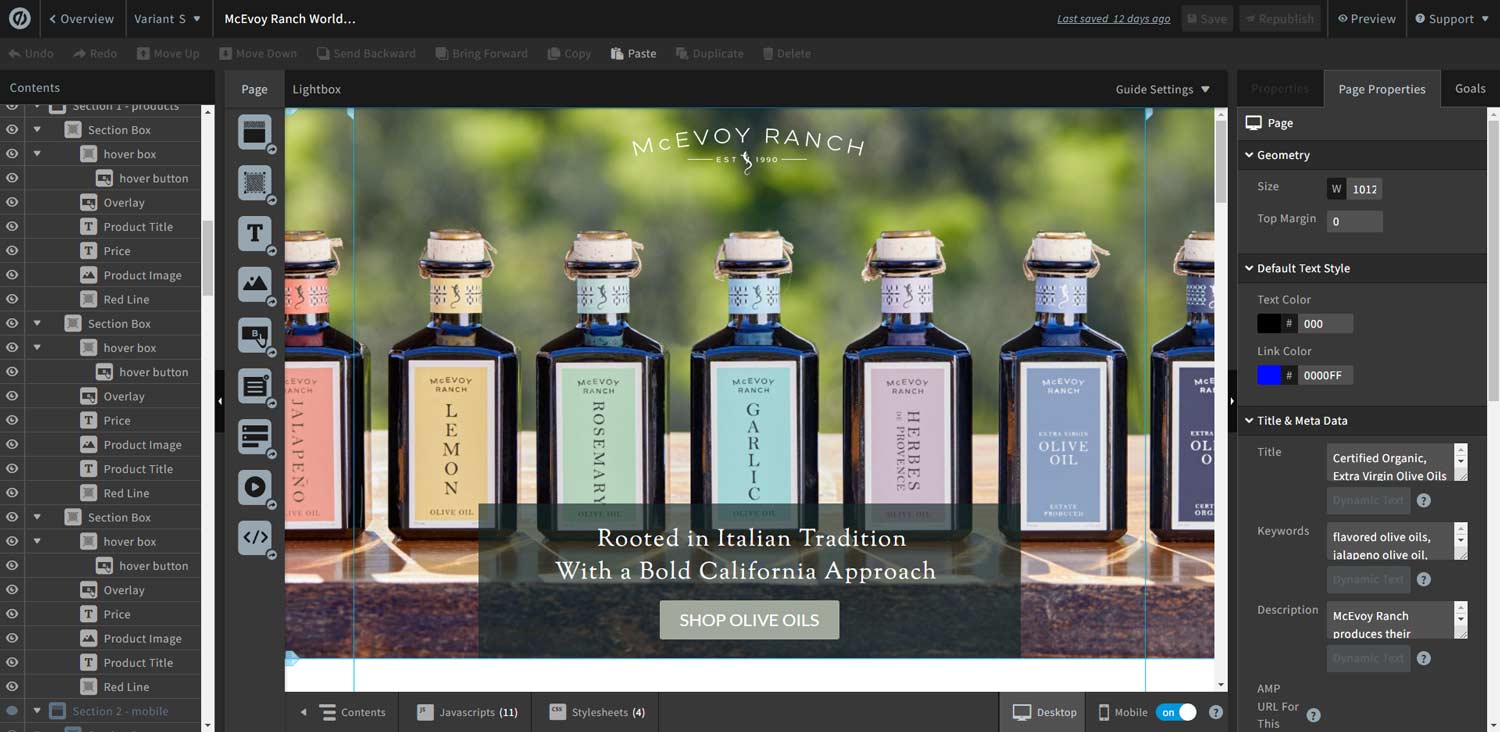
There are many great tools to build effective landing pages on the internet. Some of the most popular landing page solutions include:
- Unbounce (what we ourselves use at SevenAtoms, and the most popular overall)
- Instapage
- Clickfunnels
- Leadpages
- HubSpot
These solutions are designed to help you build a real kick-ass landing page for your business. But most people wouldn’t want to build an entire site in these tools; that’s not what they’re made for. Sites are best built using broader, more general-purpose solutions like HubSpot and WordPress.
So many businesses will keep their website and landing pages separate, using different tools entirely to create them.
Does that mean that if you use WordPress, for example, you can’t also build your landing pages directly in the software that you’re accustomed to? Of course not! There are some very popular plugins for site builders like WordPress that let you build great, effective landing pages without having to learn a whole new tool.
Plugins like Elementor and Thrive Architect work neatly with WordPress, so your landing pages can be more seamlessly integrated with the rest of your site.
However, if you are using a site builder that doesn’t have the breadth of plugins available, or if you just prefer the power and flexibility of standalone services like Unbounce, there’s no shame in continuing to use those, too!
Landing Page vs. Home Page: Conclusion
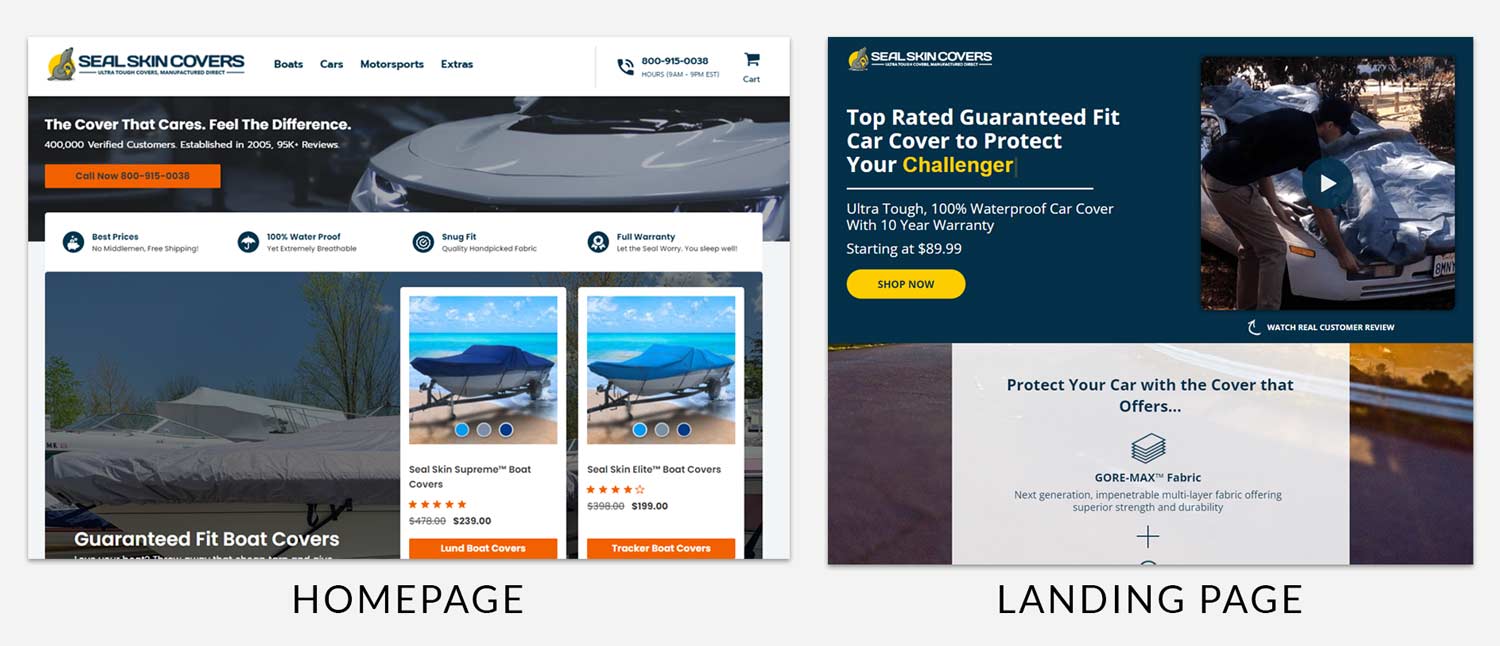
To sum up, a landing page vs. a home page isn’t a question of which is better. It’s not like we’re examining two competing methods or services – this isn’t “agile vs. waterfall” or “HubSpot vs. WordPress” or “Ben & Jerrys vs. Haagen Dazs” (Ben & Jerrys, btw). Landing pages and home pages serve very different roles for a website, but they’re both very important for any business hoping to have success with its online presence.
A home page:
- Exists to give visitors a good sense of your business’ style, values, and offerings
- Is broad, covering a wide range of topics
- Wants to get people exploring different parts of the site, existing as a hub page
- Is often built using solutions like HubSpot or WordPress
- Drives most of its traffic organically, through things like SEO
On the other hand, a landing page:
- Exists to drive a specific action, whether signing up for a mailing list, taking a demo, or buying a product
- Is very narrowly focused on one product or service, driving the aforementioned action
- Doesn’t want anyone to leave the site unless it’s through the aforementioned action – no nav bar here!
- Is often built using custom landing-page solutions like Unbounce, Instapage, or Leadpages
- Drives most of its traffic through paid ads
The two work side by side to ensure that your business is building sales through paid advertisements, while attracting an organic customer base interested in what you have to offer.
Do you want to have great landing pages and an SEO-driven home page for your business? Then you need to talk to expert digital marketers like the ones at SevenAtoms. Contact us today.

